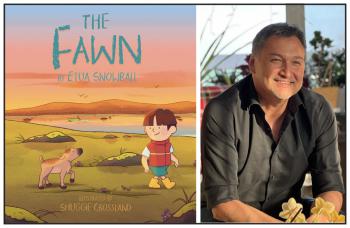Image Caption
Windspeaker.com Books Feature Writer
Local Journalism Initiative Reporter
Inuk author Etua Snowball’s third children’s book is another vivid snapshot into his life as a youngster being raised at his family’s camp in Kuujjuaq, Nunavik.
“These are my personal memoirs. How I grew up,” said Snowball. “I grew up on the land with my family… (These are) the things I wanted to put on paper and I thought people would love these kinds of books.”
The Fawn tells the true and heart-warming story of a summer when Snowball befriended a caribou fawn. Having stayed home one day from helping his father guide tourists, a little Etua “watched a caribou give birth to a tiny, slimy calf. The fawn stared at me,” he writes. From there, Etua started caring for the fawn, made it his friend and they had adventures together. “The days passed quickly, the days became weeks, and before I knew it I had spent the whole summer playing with my friend the fawn.”
But all good things must come to an end. One day, the caribou mother came back to claim her baby. Etua’s brothers returned the fawn to her. “I wanted to go after it, but my father said it was for the best to let it go,” he writes.
Letting things go has been the “message within my books,” said Snowball, which he believes is essential for children to learn.
Snowball admits it was “absolutely hard” to say goodbye to the little fawn he never named.
“Growing as a person and learning different things and moving on is a very important thing within a child's life. Growing up, with some family or animals that you befriend, things change in our lives. Being able to accept that is something that's necessary and healthy as well,” said Snowball.
And that’s not only a lesson for children to learn. “Even adults can learn this process,” he said.
The book is geared toward children ages six to eight years old, but Snowball says he has heard from many adults who have enjoyed it as well.
The Fawn is illustrated by Shuggie Crossland. Crossland also illustrated Snowball’s previous book, The Wolf Pup.
Snowball says he has never met Crossland but provided them with photographs of himself as a youngster and of the camp. The illustrations are based around those images.
That Inuit continue to live off the land and have a strong relationship with nature is something that Snowball wants non-Indigenous readers to take away from The Fawn.
“Non-Indigenous people must understand that our own people survive on the land, still live on the land and do things on the land…All of us are not suburban people…These are things that must be taken away as well, on top of learning how to let go of certain things in life,” said Snowball.
Snowball is also a musician, artist, actor, sculptor, and poet. He says all his work is based on his life.
“It’s what I see around my life as well, and my surroundings. These are the things that I make sure I put on paper or express myself in that way or another. It's something that's very important to me as a healing process as well as it's going from my lifestyle. It’s an expression of what I do,” he said.
The Fawn has been printed in both Inuktitut and English and is published by Inhabit Media. The English version of the book includes a handful of Inuktitut words. The book can be purchased at https://inhabitbooks.com/products/the-fawn.
Local Journalism Initiative Reporters are supported by a financial contribution made by the Government of Canada.

